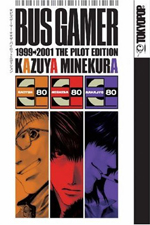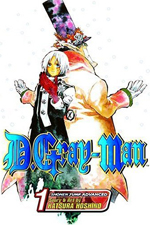
Wild Adapter, vol. 1-2
By Kazuya Minekura
Translation: Alexis Kirsch
English Adaptation: Christine Boylan
Tokyopop
ISBN-10: 1598169785 (v1) $9.99
ISBN-10: 1598169793 (v2) $9.99
In Wild Adapter, Kazuya Minekura takes readers into Japan’s underworld, where yakuza power struggles, interpersonal rivalries, and a deadly drug are the backdrop for the often ambiguous but always compelling relationship of two young men.
The story begins with Makoto Kubota, the illegitimate and unacknowledged son of a powerful man. Though Kubota has been raised by his uncle Kasai, a police detective, his skill for gambling and flair for violence ultimately bring him to attention of Yokohama’s rival yakuza groups. Kubota frightens those who know him with his cold disdain for most other people, but one day, seemingly on a whim, Kubota makes a strange choice: he takes in a “stray cat,” a young man named Tokito whom Kubota finds collapsed in an alley. Tokito has no memory of his past, but his right hand has been transformed into something more animal than human, suggesting that his life has hardly been normal. To find out the truth about Tokito’s past, Kubota and Tokito will have to unravel the mysteries of Wild Adapter, a drug that has been leaving a trail of dead and strangely inhuman bodies in its wake.
Volume 1 is basically a long prologue to the series, focusing on Kubota’s stint in the yakuza; Tokito and Kubota only meet in the last pages. In volume 2, the main story really kicks off. A year has passed since Kubota and Tokito started living together, and Kubota’s chance encounter with a troubled young woman, Saori, at a convenience store eventually brings the two young men face-to-face with some people from Kubota’s shady past.
Although this series offers readers a well-defined central mystery–who is behind Wild Adapter, and what does the drug have to do with Tokito?–the main appeal of this series is not the plot but the characterization. Kubota on his own is a somewhat interesting enigma, but Kubota interacting with Tokito is wholly fascinating, all the more because Minekura only shows us their relationship through the eyes of outsiders, like Saori. The full facts of Kubota and Tokito’s relationship–including their first year together–are as yet unseen; no doubt those revelations are being saved for later story arcs and volumes.
Wild Adapter is a more mature work than Minekura’s better-known Saiyuki in two ways. First, Wild Adapter earns its 18+ rating by being significantly more violent than Saiyuki. This content isn’t gratuitous, given the themes and settings of the story–this is a story about gangsters and mysterious illegal drugs, after all–but it’s definitely not for the faint of heart. Second, the art displays all the confidence of Minekura’s midcareer work from the first pages of volume 1; the lines and character designs are strong and polished. The development of her art between the early volumes of Saiyuki and these two volumes is noticeable; what a difference just a few years of publication (Saiyuki began serialization in 1997, while Wild Adapter began serialization in 2001) can make.
The art in Wild Adapter is also noteworthy for one stylistic choice on Minekura’s part. Every page in the series features deep black page borders of the sort that usually indicate flashbacks in manga. So far, it’s unclear whether these borders are only present for the visual effect–they do contribute the general noir atmosphere of the series–or whether they also carry their usual meaning as well. Minekura is careful to indicate that the story opens in 1995, and she provides dates later when chapters have skipped over significant chunks of time. Is it possible that readers will discover later that the entire series is being told in flashback by one of the characters? The only way to find out is to keep reading.
Tokyopop has done a fantastic job with their US editions of the series. The translation by Alexis Kirsch and adaptation by Christine Boylan are excellent; the narrative is easy to follow, while the slang fits the settings without being overly Americanized or threatening to become instantly dated. Both volumes also include four color pages–a rare treat! The color portraits of Kubota and Tokito show off all the strengths of Minekura’s distinctive art style: her attention to anatomy and her genius for facial expressions and body language.
Wild Adapter is definitely a series to watch, not just for Minekura’s usual shonen-ai-loving fans but also for fans of noir. The story does get off to a rather leisurely start in volume 1, but the beginning of the story proper in volume 2 is promising. I’ll be reading future volumes with a great deal of interest.
Review originally published at MangaLife.com.
 Ouran High School Host Club is a shojo manga series that both embraces and pokes fun at the storytelling conventions that diehard manga readers have come to know, love, and occasionally mock. The protagonist, Haruhi Fujioka, is a poor but brilliant scholarship student attending the posh Ouran Academy. Haruhi is so blasé about her appearance that she doesn’t bother to purchase a girl’s uniform, and is thus generally mistaken for a boy. When she accidentally breaks a costly vase belonging to the Host Club, the school’s most elite and eccentric school club, she’s forced to repay her debt by becoming a member–first by working as the club’s gopher, and later by becoming a full-fledged host. Surrounded by bishonen with lots of wealth and little common sense, Haruhi discovers first-hand how the other half lives.
Ouran High School Host Club is a shojo manga series that both embraces and pokes fun at the storytelling conventions that diehard manga readers have come to know, love, and occasionally mock. The protagonist, Haruhi Fujioka, is a poor but brilliant scholarship student attending the posh Ouran Academy. Haruhi is so blasé about her appearance that she doesn’t bother to purchase a girl’s uniform, and is thus generally mistaken for a boy. When she accidentally breaks a costly vase belonging to the Host Club, the school’s most elite and eccentric school club, she’s forced to repay her debt by becoming a member–first by working as the club’s gopher, and later by becoming a full-fledged host. Surrounded by bishonen with lots of wealth and little common sense, Haruhi discovers first-hand how the other half lives.  Mushishi, Vols. 1-3
Mushishi, Vols. 1-3 I first heard of director Shinkai Makoto through a brief mention of his work in
I first heard of director Shinkai Makoto through a brief mention of his work in  My review of
My review of  My review of
My review of 






 D.Gray-Man, Vol. 1
D.Gray-Man, Vol. 1 Re-Gifters
Re-Gifters